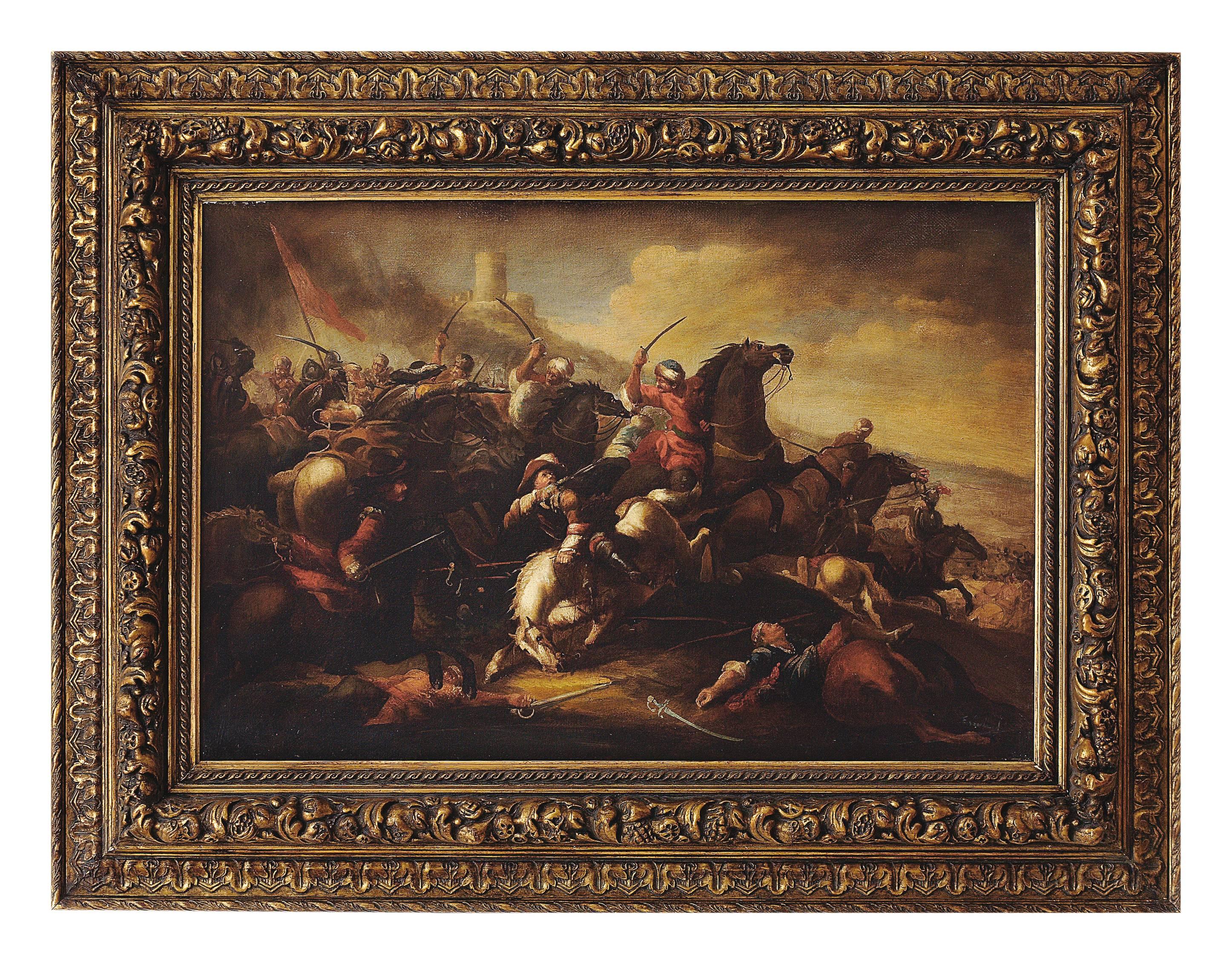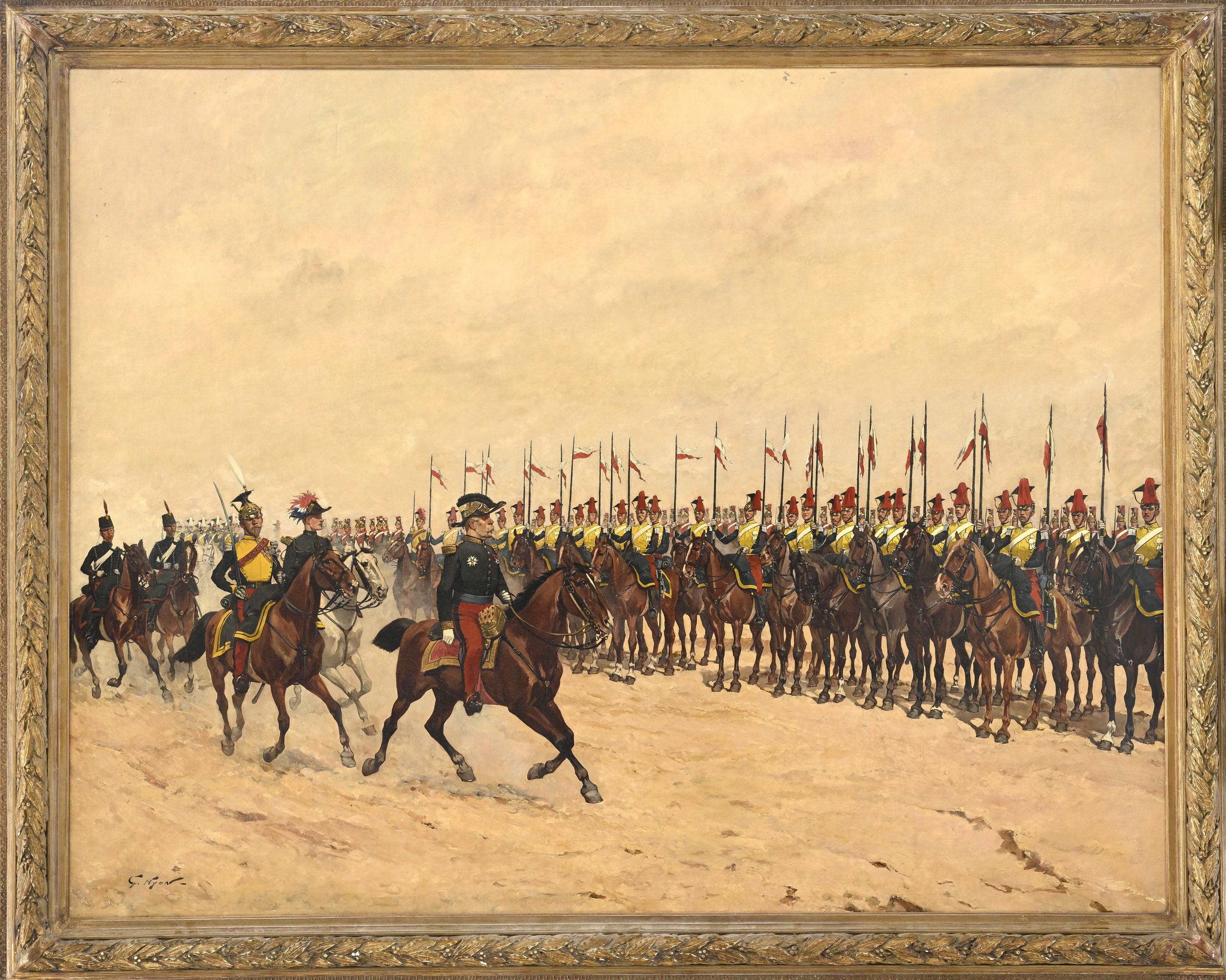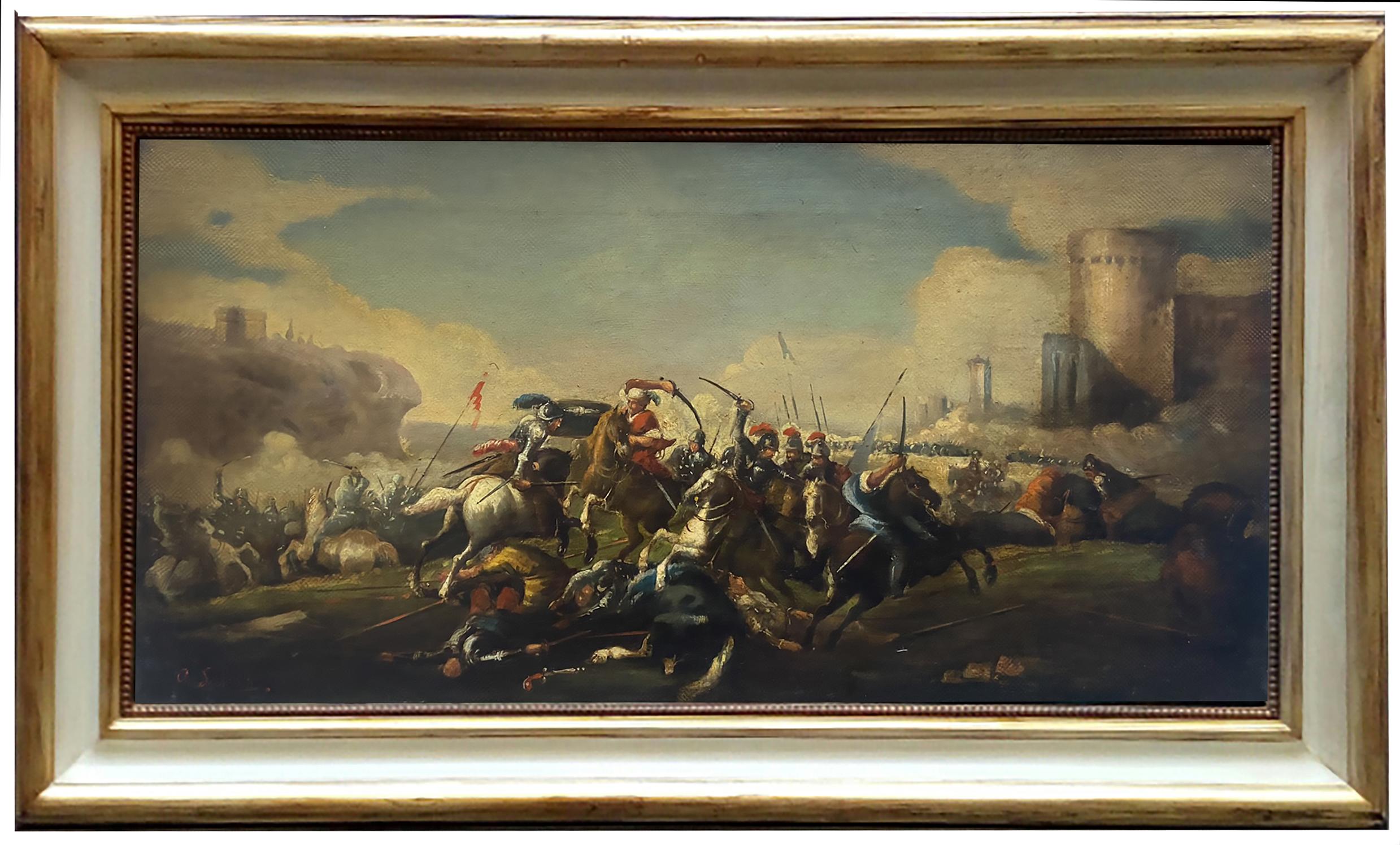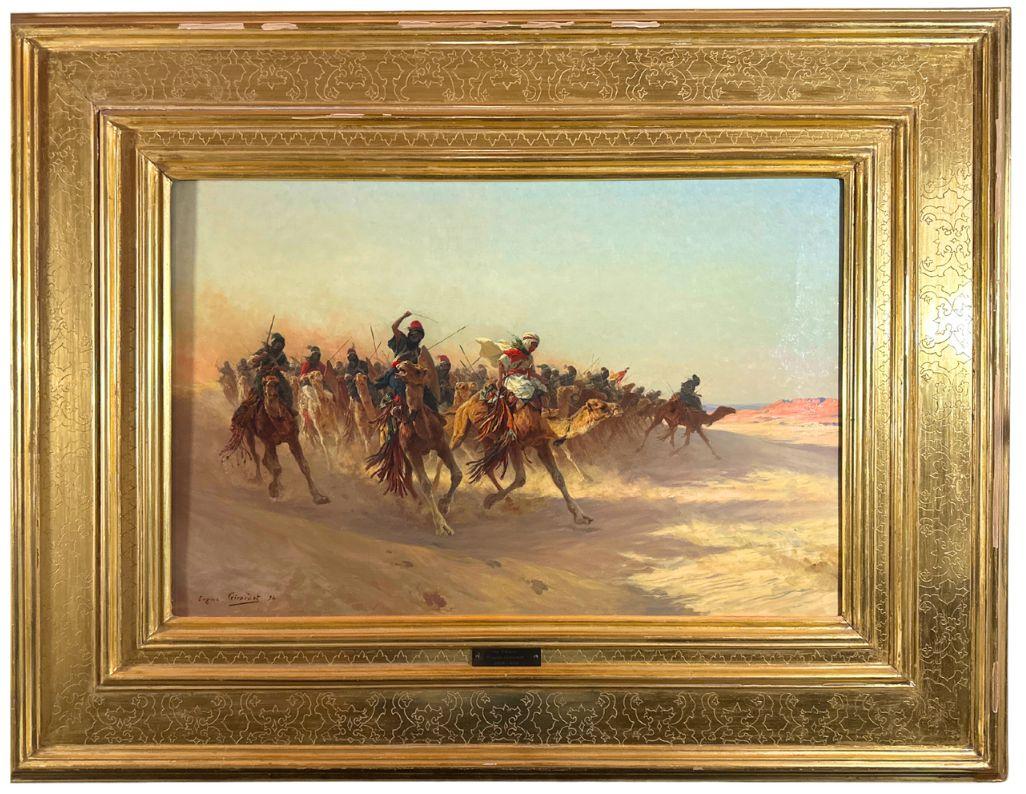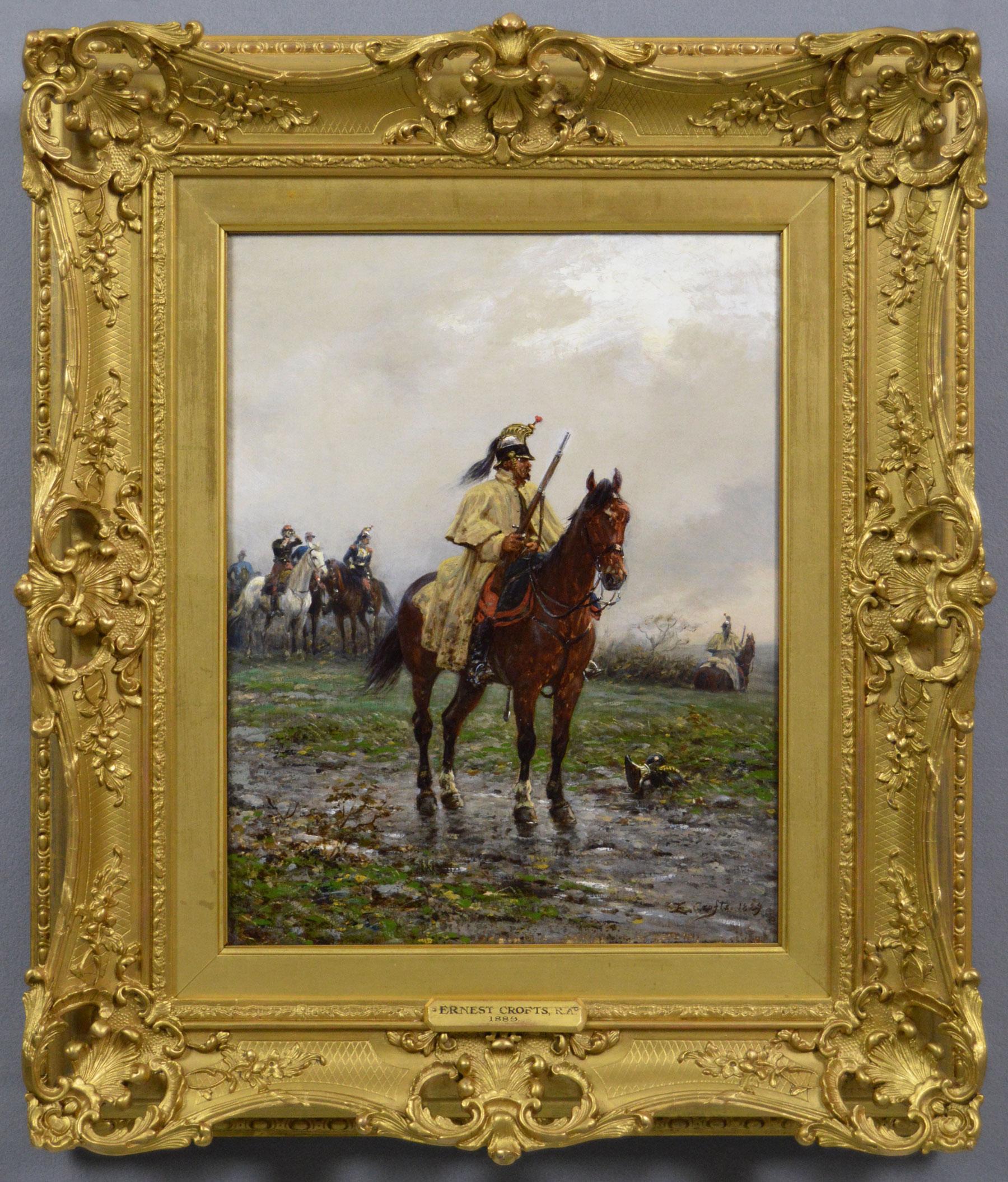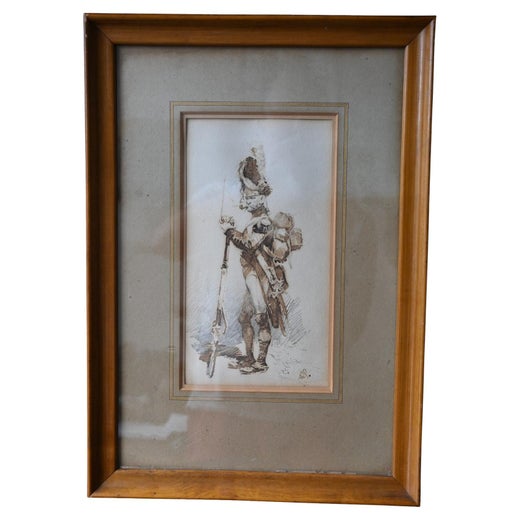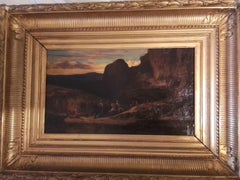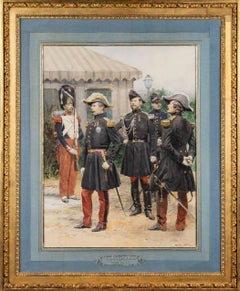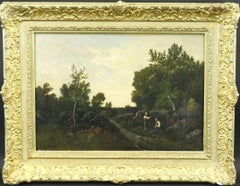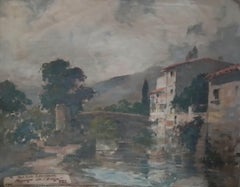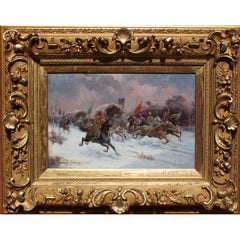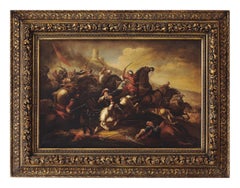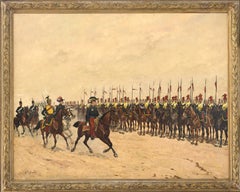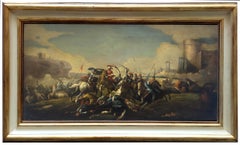Items Similar to Cavalry Charge 1st Empire - Edouard Detaille - French art
Want more images or videos?
Request additional images or videos from the seller
1 of 17
Jean Baptiste Édouard DetailleCavalry Charge 1st Empire - Edouard Detaille - French art1904
1904
$10,195.09
£7,678.93
€8,650
CA$14,059.46
A$15,795.17
CHF 8,253
MX$192,787.49
NOK 104,789.03
SEK 98,636.80
DKK 65,840.51
About the Item
Conditions : Very good original Conditions including a beautiful frame. Framed under glass, this rare composition for sale is an exceptionnel piece for Art collectors.
Signed and dated on the lower right.
Free Continental US Shipping and Worlwide included.
Artist Biography.
Born in 1848 in a fairly rich and large family, Edouard Detaille was the eldest of eight children. Since his childhood he had shown facilities at drawings. "He was a gifted kid", said François Robichon. At thirteen, he had an amazing facility to draw, a phenomenal sense of composition. His father, a friend of Horace Vernet, was determined of it. At the age of seventeen, his highschool degree in hand, he started to study at Ernest Meissonier's studio in Poissy. This partnership resulted in a reciprocal affection. Thus, Edouard Detaille had the option to disregard any studies at an Art School also called "Ecole des Beaux-Arts". As for the teaching, rather than dictate an art called "official" Meissonier, already at the top of his fame, traveled with his students to Brussels and Lille.
In 1867, as Paris embrased the free trade world with the Exposition Universelle, the young man was discovering the Salon of the Imperatrice Mathilde and the Dumas's son theater. He knew and was confident of his
talent, and was determined to climb the ladder to reach the circle of the most powerfull people without loosing his freedom.
His first painting took part of the exposition of 1868 and was called "La Halte des Tambourgs". Princesse Mathilde acquired it for its beauty and simplicity of the subject. She was the cousin of the Empereur Napoleon. Detaille was not even 20 years old and was already becoming a successfull. He started to be known by a cicrle of artist like Sainte-Beuve, Theophile Gautier, the Goncourt brothers and Flaubert.
His humanist vision was more sensitive than that of his ancestors.
His paintings showed soldiers on the field doing their duties and exercise.
The vision of a soldier
While Paris was under siege in 1870, Detaille lost 2 brothers. Certainly influenced by that, from 1871 and on he did not hide the cruaulty of the
war in his representaitons.
This artist remembered what Meissonier taught when in his studio:
Nature, nature and always the nature. He also remembered the teaching of
Corot, Courbet and Manet who taught him the same.
After living rue Legendre from 1872 to 1875, he built his own house or
"hotel particulier" at age 26. The adress was 129 Blvd Malheserbe in
Paris. There, he could receive some well known people such as Valtesse de
la Bigne.
A great diplomat
With his fame increasing over the years, his House was the place where
many foreign prince and princess met regularly.
Invited at The Castle of Windsor, he became a personal friend of the Tsar
Alexandre III a great friend of Felix Faure.
He won several medals and "The Dream" exposed at the Musee d'Orsay in Paris received the price of Honor in 1899.
His willingness to transform his house into a Museum "Musee Detaille"
after his death did not occur even though he left everything to the state.
Howver, Detaille, partly founder of the actual Musee de l'Armee, has many
of his works exposed there.
He died on December 24th 1912, at his home.
- Creator:Jean Baptiste Édouard Detaille (1848 - 1912, French)
- Creation Year:1904
- Dimensions:Height: 27.56 in (70 cm)Width: 19.69 in (50 cm)Depth: 1.97 in (5 cm)
- Medium:
- Movement & Style:
- Period:
- Condition:
- Gallery Location:PARIS, FR
- Reference Number:1stDibs: LU2804216525082
Jean Baptiste Édouard Detaille
Jean-Baptiste Édouard Detaille (Paris 5 October 1848 – 23 December 1912 Paris) was a French academic painter and military artist noted for his precision and realistic detail. Detaille grew up in a prosperous military family in Picardy; his grandfather had been an arms supplier for Napoleon. An amateur artist who was friends with a number of collectors and painters, including Horace Vernet, Detaille's father encouraged his son's artistic endeavors. He began his artistic studies at age seventeen under the famous military painter Jean-Louis-Ernest Meissonier; he had originally approached him to ask for an introduction to the renowned Alexandre Cabanel but Meissonier decided to teach Detaille himself. Meissonier became a major influence on his style, and it was he who inculcated an appreciation for accuracy and precision in Detaille.
Detaille made his debut as an artist at the Salon—the official art exhibition of the Académie des Beaux-Arts—of 1867 with a painting of Meissonier's studio. At the Salon of 1868, he exhibited his first military painting, The Drummers Halt, which was based solely on his imagination of the French Revolution. With Repose During the Drill, Camp St Maur, which he debuted the following year, Detaille established his reputation as a painter. In the spring of 1870, he went on a "sketching trip" to Algeria with three other young painters, Étienne-Prosper Berne-Bellecour, Alexander Louis Leloir, and Jehan Georges Vibert.
Detaille enlisted in the 8th Mobile Bataillon of the French Army when the Franco-Prussian War broke out in 1870; by November he was seeing and experiencing the realities of war. This experience allowed him to produce his famed portraits of soldiers and historically accurate depictions of military manoeuvres, uniforms, and military life in general. He eventually became the official painter of the battles. He published a book called L'Armée Française in 1885, which contains over 300 line drawings and 20 color reproductions of his works. Detaille was one of the first artists to buy photographs from Eugène Atget.
In 1912, Detaille created new uniforms for the French army. They were never adopted by the Minister of War, but the blue-gray greatcoats would influence later French World War I uniforms, and the Adrian helmet was heavily influenced by his designs.
During his life, he had amassed an impressive collection of military uniforms and artifacts and bequeathed to the Musée de l'Armée in Paris following his death.
Detaille appears as a guest at a party at the home of the Princesse de Guermantes in Part Two: Chapter One of Marcel Proust's novel, Cities of the Plain, where Detaille is referred to as "the creator of the Dream", his 1888 painting also known as Le Rêve (The dream) which shows soldiers asleep on a battlefield dreaming of military glory. The painting, which is located at the Musée d'Orsay in Paris.
About the Seller
5.0
Vetted Professional Seller
Every seller passes strict standards for authenticity and reliability
Established in 2024
1stDibs seller since 2024
10 sales on 1stDibs
Typical response time: <1 hour
- ShippingRetrieving quote...Shipping from: PARIS, France
- Return Policy
Authenticity Guarantee
In the unlikely event there’s an issue with an item’s authenticity, contact us within 1 year for a full refund. DetailsMoney-Back Guarantee
If your item is not as described, is damaged in transit, or does not arrive, contact us within 7 days for a full refund. Details24-Hour Cancellation
You have a 24-hour grace period in which to reconsider your purchase, with no questions asked.Vetted Professional Sellers
Our world-class sellers must adhere to strict standards for service and quality, maintaining the integrity of our listings.Price-Match Guarantee
If you find that a seller listed the same item for a lower price elsewhere, we’ll match it.Trusted Global Delivery
Our best-in-class carrier network provides specialized shipping options worldwide, including custom delivery.More From This Seller
View AllOrientalist cavalry scene Decamps Gabriel - oil on canvas - initials DC
Located in PARIS, FR
Conditions : Excellent overall Condition.
Great Master of Orientalism:
Decamps revealed Orientalism at the 1831 Salon, establishing himself as an essential reference. The 1831 Salon...
Category
19th Century Realist Landscape Paintings
Materials
Oil
Napoleon III-Review by Edouard Detaille - Tempera - signed lower right
By Jean Baptiste Édouard Detaille
Located in PARIS, FR
This artwork might be one of two versions, the other one being in the Museum in les Invalides Paris.
Note. This version has a more accomplished academic style.
Dimensions with original gold frame 107 x 87 cm
Conditions Excellent overall, supported by an original frame withan antique glass.
EDOUARD DETAILLE
The emperor is accompanied by his aide-de-camp, Colonel Castelnau, and Marshal Canrobert. In a gilded wooden frame, under a Marie Louise blue background.
Life and time
Born in 1848 into a close-knit bourgeois family, Édouard Detaille, the eldest of eight children, displayed early talent in drawing. “He was a prodigy,” notes François Robichon. By the age of thirteen, he exhibited an astonishing surety of hand and a phenomenal sense of composition. His father, connected to Horace Vernet, encouraged him. At seventeen, after passing his baccalaureate, he entered Meissonier’s studio. This relationship, which developed into mutual affection, spared Detaille the academic detour through the École des Beaux-Arts. Rather than dictating an official art style, Meissonier, at the peak of his fame, traveled with his students, introducing them to the nuances of Titian, Rembrandt, and Rubens in Brussels and Lille.
In 1867, the Paris of “free trade” dominated the world through the technological revolutions of the Universal Exhibition, and the amiable young man, striking in appearance, discovered the salon of Princess Mathilde and the theater of Dumas fils. He even approached the Empress, noting in his journals, “Not bad, the Empress.” This observation encapsulated Detaille: he had no doubts about his talent, cultivated panache, enjoyed the company of beautiful women, and aimed to conquer the circles of power without sacrificing his freedom.
From childhood, he listened to his calling: “Before I could read, I could guess the subjects of battles, the names of famous generals, the weapons of officers and soldiers from the images I admired in the books of Norvins and Laurent de l'Ardèche.” He mingled with collectors and regularly attended military reviews on the Champs-Élysées. His first painting exhibited at the Salon in 1868, “La Halte de tambours,” was praised by critics who immediately recognized “a remarkable truth of observation and simplicity of effect.” The purchase of this work by Princess Mathilde, cousin of Emperor Louis-Napoleon, made Detaille, at twenty, an envied celebrity known to Sainte-Beuve, Théophile Gautier, the Goncourt brothers, and Flaubert. The young artist’s humanistic vision contrasted with the compositions of his predecessors, depicting soldiers in maneuvers, contemplative and resigned as war loomed.
**The Combatant’s Vision**
The Siege of Paris, where he nearly lost his life in 1870, and the deaths of two brothers in that defeat darkened his outlook. From 1871 onward, Detaille no longer concealed the cruelties of war: German riflemen mowed down by machine gun fire, cavalrymen and panicked horses caught in ambushes, fields plowed by shells strewn with dead animals. The unvarnished tragedy: “It is an absolute fact that no painter has ever rendered a battlefield covered with corpses as it is,” commented Jules Claretie. The fallen bodies still bear the appearance of life in their frozen rigidity. Detaille’s testimony of the devastating defeat and the catastrophic effects of the first total war in history was not a celebration of heroism but a lament, a “lesson in darkness.” “From war, once considered the supreme effort of human genius, we now see only melancholy and horrors,” judged one writer in response to his canvases.
“Detaille experienced the reality of combat at a young age during a war that foreshadowed the two world conflicts of the 20th century,” explains François Robichon. With great realism, Detaille painted war from the perspective of the combatant. He introduced a humanity and a critical lucidity regarding the evolution of warfare. His works intensely captured the violence and firepower of new weapons like machine guns. Before he turned thirty, Detaille had become a chronicler of these painful years. He exhibited, as a critic noted, a “striking portrait of modern war” that both French civilians and soldiers had experienced firsthand. He embodied a youth humiliated and eager for revenge. Yet this scrupulous artist also remembered, in his expansive landscapes—from the chalky plateaus of Île-de-France to the Russian plains—the lessons of Corot and Courbet. Manet was not far off. “I wouldn’t want my art to be reduced to mere patriotic art,” he asserted. “A system I often employ and love is to first execute the landscape, very effective, very tight, based on nature…” Echoing Meissonier’s advice: “Always nature, always nature!” Detaille remained close to this father figure, constructing a grand townhouse next to his mentor’s studio at 129 boulevard Malesherbes at the age of 26, having purchased 425 m² of land from the Pereire brothers. He even chose the same architect as Meissonier: Paul Boesvilwald. A bachelor and incorrigible seducer, the painter welcomed his conquests, including Valtesse de la Bigne, amidst his collections, having built his studio in the courtyard.
Diplomatic Actor
As Detaille’s fame grew, his Malesherbes townhouse quickly became a gathering place for foreign princes, politicians, and heads of state, where Juliette Adam, Léon Gambetta’s muse, offered him valuable advice. The Prince of Wales, the future Edward VII, developed a genuine friendship with the painter. “This fervent patriot, friend of Déroulède, was extraordinarily open to the world,” recounts François Robichon. In just a few years, he gained considerable social, cultural, and international stature. Received at Windsor, at the English court, he was close to Tsar Alexander III and a great friend of Félix Faure.
In this capacity, Detaille played a decisive role in the Entente Cordiale, signed in 1904 between England and France, and in the Franco-Russian alliance of 1894, thereby contributing to the Triple Entente among the three powers. An engaged witness of his time—associated with the birth of the “Ligue des Patriotes” alongside Alphonse de Neuville...
Category
Late 19th Century Academic Landscape Paintings
Materials
Gouache
Landscape in the Fontainebleau forest
Located in PARIS, FR
Conditions: Excellent overall Conditions. No prior restorations under UV light. Signed lower left "P Vernon". An oil on wood panel. The frame is an original french stuck frame. ( m...
Category
Late 19th Century French School Landscape Paintings
Materials
Oil
Vintage french art painting by Paul emile Lecomte - oil on canvas, signed
By Paul Emile Lecomte
Located in PARIS, FR
Old exhibition label. Free US CONTINENTAL Shipping, incl Europe and Asia.
Provenance: Artist's family, atelier sale. Excellent condition under UV light with no prior restoration. T...
Category
Late 19th Century Impressionist Landscape Paintings
Materials
Oil
Antique art painting with sheeps in a barn
Located in PARIS, FR
Conditions: In excellent overall conditions, with no repaint under UV light, original canvas and frame. Signed Lower left "Ls Reinhardt". Dimensions with the frame are approximately...
Category
Late 19th Century Impressionist Landscape Paintings
Materials
Oil
Victorian vintage art by Dibdin, watercolor tempera - 1863
Located in PARIS, FR
Excellent condition. Mint.
Free US CONTINENTAL shipping, incl Europe and Asia.
Thomas Colman Dibdin was an illustrator and painter. Born at Bletchworth, Surrey, on 22 October 1810,...
Category
Late 19th Century Impressionist Landscape Paintings
Materials
Watercolor, Gouache, Carbon Pencil
You May Also Like
A Fine Austrian/Russian Oil on Board "Charging Cossack Warriors on Horseback"
Located in LA, CA
Adolf Constantin Baumgartner Stoiloff (Austrian/Russian, 1850-1924) a fine oil on board "Charging Cossack Warriors on Horseback" ...
Category
Late 19th Century Baroque Figurative Paintings
Materials
Gold Leaf
CAVALRY BATTLE - Antonio Savisio -Neapolitan School Oil on canvas Painting
By Antonio Savisio
Located in Napoli, IT
Land battle - Antonio Savisio Italia 2006 - Oil on canvas cm.60x90.
Gold leaf gilded wooden frame cm.92x122
Maestro Antonio Savisio drew inspiration from the masterpieces of the gr...
Category
Early 2000s Old Masters Figurative Paintings
Materials
Canvas, Oil
Cavalry review of the 2nd Lancers regiment
Located in BELEYMAS, FR
Georges HYON
(Paris 1840 – Saint Germain en Laye 1913)
Cavalry review of the 2nd Lancers regiment
Oil on canvas
H. 115 cm; W. 146.5 cm
Signed lower left
A student of Portalis, Georg...
Category
1870s French School Portrait Paintings
Materials
Canvas, Oil
CAVALRY BATTLE - Antonio Savisio - Neapolitan School - Oil on canvas Painting
By Antonio Savisio
Located in Napoli, IT
Land Battle - Antonio Savisio Italia 2006 - Oil on canvas cm. 40x80
Maestro Antonio Savisio drew inspiration from the masterpieces of the great Neapolitan Maestro Salvator Rosa who...
Category
Early 2000s Italian School Figurative Paintings
Materials
Canvas, Oil
The Charge 19th-century Realism Antique Oil Painting on Canvas, Signed
By Eugene Alexis Girardet
Located in Jacksonville, FL
The painting is signed and dated 1894
Description:
Eugene Alexis Girardet (1853-1907) was a prominent Swiss painter known for his remarkable attention to detail and his ability to capture vivid and dynamic scenes. Born in Paris, France, Girardet came from a family of artists and received early artistic training from his father, Paul Girardet, and his uncle, Jules Girardet, both respected engravers. He later studied at the prestigious École des Beaux-Arts in Paris, where he honed his skills and developed a deep appreciation for historical and orientalist subjects.
He was interred at the Père-Lachaise Cemetery. In addition to several museums in France, his works may be seen at the Dahesh Museum of Art and the National Museum of Fine Arts of Algiers, as well as at museums in Switzerland and New York City.
Girardet’s artwork often depicted historical and exotic scenes, particularly focusing on Middle Eastern and North African themes. His meticulous attention to detail and his ability to convey a sense of movement and drama made his works highly sought after. One of his most renowned paintings, “The Charge,” exemplifies his exceptional talent and his ability to create a captivating and immersive experience for viewers.
In “The Charge,” Girardet presents an army of Arab camel...
Category
19th Century Academic Figurative Paintings
Materials
Oil, Canvas
19th Century historical military oil painting of a French Cuirassier on a horse
By Ernest Crofts
Located in Nr Broadway, Worcestershire
Ernest Crofts
British, (1847-1911)
The Search Party
Oil on canvas, signed & dated 1889
Image size: 17.5 inches x 13.5 inches
Size including frame: 27 inches x 23 inches
An excellen...
Category
19th Century Figurative Paintings
Materials
Canvas, Oil
More Ways To Browse
French Empire Paintings
French Cavalry
Cartier China
Connecticut Dealers
Dog Boat
J Peters
Painting With Swimming Pools
R Wilson
Andrew Wyeth Studys
Dutch Winter Scene Painting
James Sheldon
Jamieson Oil Painting
Painting Blossoming Trees French
Pont Neuf Paris
Regatta Painting
Richard Lewis
Signed A Lefebvre
Snow White Garden

